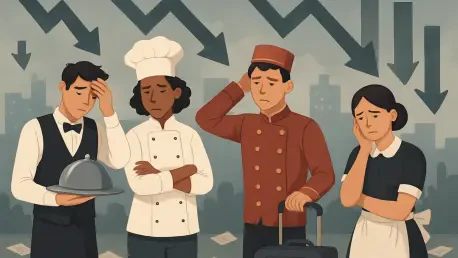What happens when the heart of a community—vibrant restaurants, cozy pubs, and inviting hotels—starts to crumble under financial pressure? Britain’s hospitality sector, a cornerstone of both economy and culture, is grappling with an unprecedented crisis that threatens not just livelihoods but the very fabric of social life. Recent figures paint a grim picture, revealing that this industry has suffered the most significant job losses across the UK job market. This alarming trend demands attention.
A Vital Industry Faces a Shrinking Workforce
The hospitality sector has long been a backbone of employment, offering opportunities to millions, from seasoned chefs to first-time servers. Yet, data from the Office for National Statistics (ONS) shows a disturbing decline, with payrolled positions dropping for ten of the past twelve months. This industry, alongside retail, has borne the brunt of job cuts since late last year, signaling a deeper malaise that could reshape local economies.
Beyond the numbers lies a stark reality: businesses are closing doors or scaling back operations. Hotels are reducing staff hours, and small cafes are struggling to keep up with demand without adequate manpower. The ripple effect touches not just employees but also suppliers and customers who rely on these establishments for goods, services, and a sense of community.
Unpacking the Pressures on Hospitality
At the core of this crisis are policy-driven cost increases that have hit hospitality harder than most sectors. Since earlier this year, employer National Insurance Contributions (NICs) and minimum wage hikes have squeezed businesses already operating on razor-thin profit margins. These changes, while aimed at improving worker pay, have inadvertently pushed many employers to the edge, forcing tough decisions about staffing.
The broader economic landscape adds to the strain, with unemployment holding at 4.7%, a notable rise from the pre-pandemic low of 3.9%. A cooling jobs market means fewer customers with disposable income, further denting revenue for restaurants and bars. This toxic combination of internal cost pressures and external economic challenges creates a perfect storm for an industry reliant on high-volume, low-wage labor.
The Crisis in Numbers: Jobs, Vacancies, and Vulnerable Groups
Diving into the specifics, the scale of job losses is staggering. Hospitality has seen consistent declines in employment, with the ONS reporting it as the hardest-hit sector alongside retail over recent months. This isn’t a temporary blip; it’s a sustained trend that reflects deep structural issues within the industry.
Job vacancies have also plummeted, falling to 718,000 in June, down 44,000 from the previous quarter. This drop, part of a downward trajectory since early 2022, indicates a shrinking pool of opportunities for job seekers. Employers are hesitant to hire amid uncertainty, leaving many roles unfilled or eliminated entirely.
The human toll is most evident among younger workers, who often depend on hospitality for entry-level or seasonal positions to build skills and experience. With fewer openings, a generation risks being locked out of the workforce at a critical stage. Take the example of a local restaurant chain in Manchester, which recently cut half its staff—many of them teenagers and young adults—due to unsustainable wage costs. Such stories are becoming all too common across the country.
Industry Voices: Struggles and Insights from the Frontlines
To understand the depth of this crisis, perspectives from key figures shed light on the challenges. Liz McKeown, director at the ONS, has highlighted the sharp reduction in job offerings within hospitality, noting it as a standout concern in recent labor market reports. Her analysis underscores how systemic economic shifts are disproportionately affecting this sector.
Kate Nicholls, chair of UKHospitality, adds a poignant industry viewpoint, stressing that policy-driven costs like NIC hikes unfairly burden hospitality and retail. “These sectors are labor-intensive by nature, and every additional cost forces impossible choices,” she remarked. Her words echo the frustration of countless business owners facing shrinking budgets.
Stories from the ground amplify these expert views. A pub owner in Birmingham shared how rising wages forced the closure of a second location, laying off a dozen workers in the process. Such personal accounts reveal the emotional and financial weight of decisions that statistics alone cannot capture, painting a vivid image of an industry in distress.
Charting a Path Forward: Solutions for Businesses and Policymakers
Amid these challenges, actionable strategies offer a glimmer of hope for hospitality businesses and policymakers alike. For operators, embracing technology—such as automated ordering systems—can reduce reliance on large staffs while maintaining service quality. Cross-training employees to handle multiple roles also helps optimize limited resources without sacrificing efficiency.
On the policy front, targeted relief could make a significant difference. Temporary reductions in NICs or grants for labor-intensive industries might ease the immediate burden, preventing further job cuts. Additionally, subsidized training programs for young workers could ensure they aren’t sidelined, preserving a pipeline of talent for the future.
Collaboration between stakeholders remains critical. Industry leaders must advocate for tailored support, while policymakers should prioritize dialogue with affected businesses to craft solutions that address real-world needs. Though the road ahead is tough, these steps provide a framework to stabilize the sector and protect its vital role in society.
Reflecting on a Troubled Chapter
Looking back, the hospitality sector endured a relentless battle against rising wage costs and shrinking workforces. Each cut to staff, each drop in vacancies, marked a deeper wound to an industry that once thrived on human connection. The struggles of young workers and small business owners stood as stark reminders of the stakes involved.
Yet, amidst the hardship, seeds of resilience were sown. Conversations around policy reform gained traction, with calls for tax breaks and training initiatives echoing louder than ever. Moving forward, the focus shifted to rebuilding—ensuring that businesses could adapt through innovation while safeguarding opportunities for the next generation. This chapter, though painful, sparked a renewed commitment to balance economic realities with the human spirit of hospitality.









